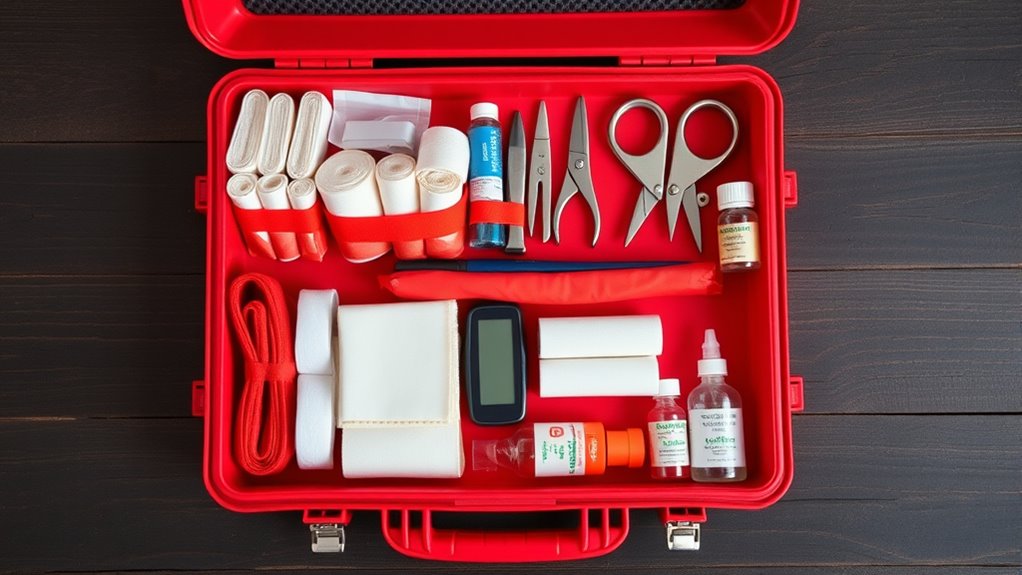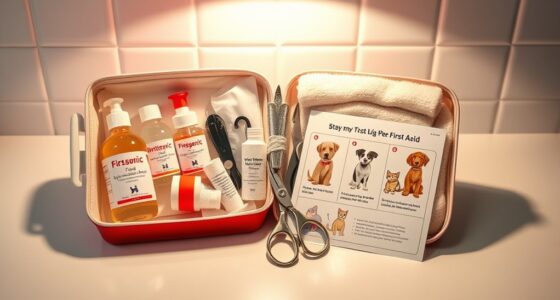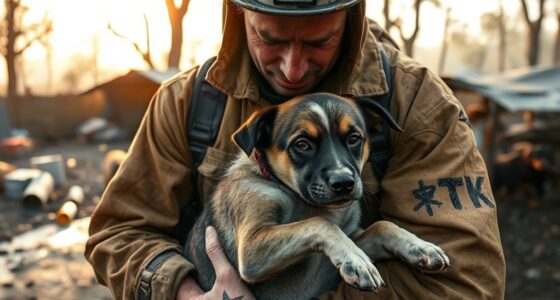A well-stocked first-aid kit for working dogs should include essential bandages and dressings like sterile gauze and non-stick pads, antiseptic wipes and solutions to prevent infection, and adhesive tapes or wraps to secure everything. You’ll also need tools such as scissors, as well as restraint devices and PPE like gloves and eye protection to stay safe. For more detailed essentials and tips, keep exploring how to prepare your kit for any emergency.
Key Takeaways
- Include sterile dressings, gauze, bandages, and adhesives for effective wound management.
- Stock antiseptic solutions, antibiotic ointments, and pain relief topicals to prevent infection and promote healing.
- Prepare immobilization tools like splints, slings, and appropriate harnesses for injury stabilization.
- Equip PPE such as gloves, goggles, and protective clothing to ensure safe handling of injured dogs.
- Maintain emergency contacts, specialized supplies like tourniquets, and a comprehensive kit for various scenarios.
Essential Bandages and Dressings
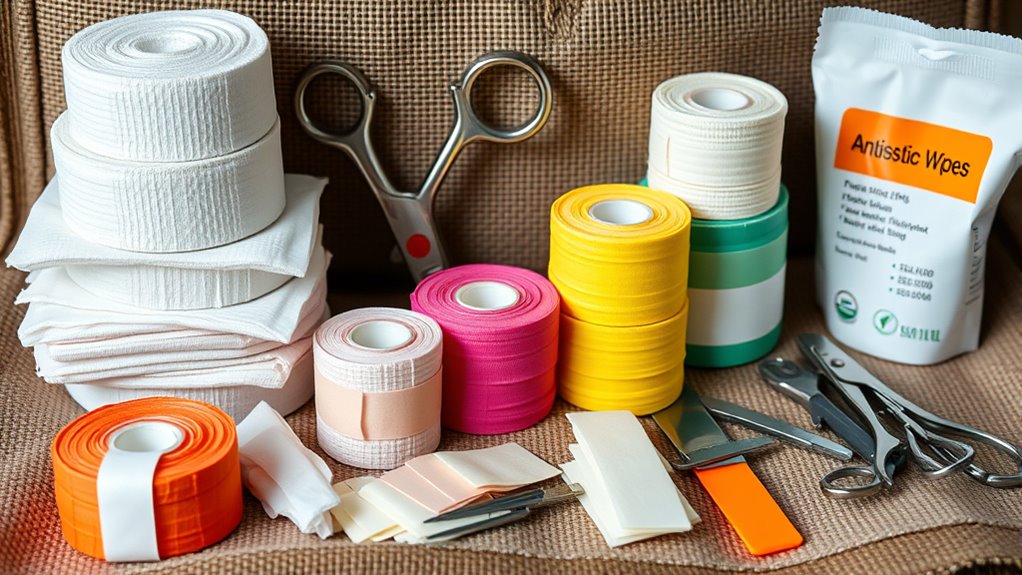
Having the right bandages and dressings on hand is essential for effectively treating injuries in working dogs. In dog first aid, proper bandaging helps control bleeding, protect wounds, and prevent infection. Choose sterile gauze pads for covering open cuts and abrasions, and use non-stick dressings to prevent sticking to the wound. Elastic bandages provide support and secure dressings in place, especially for canine injuries that involve swelling or joint issues. Always verify the bandage isn’t too tight, as it can restrict circulation. Keep a variety of sizes available to fit different injuries. Proper bandaging not only stabilizes injuries but also keeps dirt and debris out, promoting faster healing. Using self-watering techniques can help ensure that wounds stay moist and promote faster healing during recovery, which is an important aspect of wound care in first aid. Additionally, understanding vetted products ensures that the supplies used are safe and effective for canine injuries. Incorporating performance kits designed for canine first aid can enhance treatment effectiveness and preparedness. Regular training on proper bandaging methods ensures that handlers can apply dressings effectively and avoid complications.
Antiseptic Solutions and Wipes

Antiseptic solutions and wipes are essential tools in your first-aid kit for working dogs, as they help prevent infection and disinfect wounds quickly. Antiseptic solutions, such as iodine or chlorhexidine, are effective for cleaning minor cuts and abrasions, reducing bacteria on the skin. Wound cleaning wipes offer a convenient, no-mess way to sanitize damaged areas on the go. Keep a bottle of antiseptic solution for thorough cleaning, and include wound cleaning wipes for quick response during active work. These supplies help you manage injuries efficiently, minimizing the risk of infection and promoting faster healing. Regularly check expiration dates and replace used or expired items to guarantee your antiseptic tools remain effective when needed most. Incorporating remote collaboration tools can also facilitate quick consultation with veterinary experts during emergencies, especially when working in remote locations. Understanding proper wound care techniques can significantly improve recovery outcomes for working dogs in the field. Additionally, being familiar with asset division principles can be beneficial in case of legal disputes over shared equipment or resources.
Sterile Gauze and Padding

Why is sterile gauze and padding essential in your first-aid kit for working dogs? They’re indispensable for controlling bleeding and preventing infection. Sterile gauze helps you cover wounds securely, absorbing blood and debris while creating a barrier against bacteria. Padding materials provide cushioning to protect injured tissues and reduce pain during transport. Using appropriate sterile gauze ensures you don’t introduce new contaminants, which is critical in emergency situations. Padding also helps stabilize fractures or swollen areas, preventing further injury. Keep a variety of sizes of sterile gauze on hand to adapt to different wound types. Combining sterile gauze with padding materials allows you to create effective, protective bandages that keep wounds clean and comfortable until professional help arrives.
Adhesive Tapes and Wraps
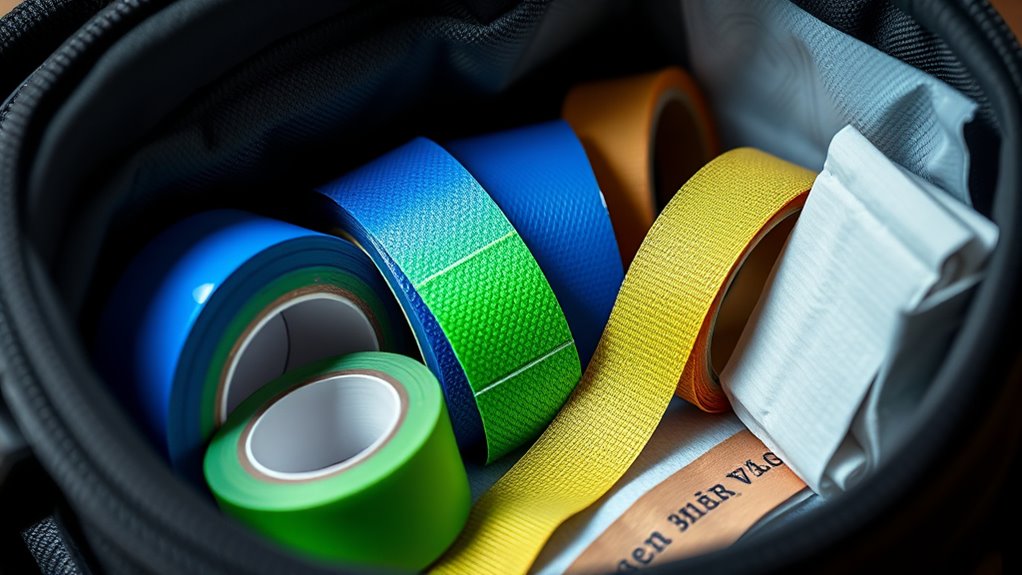
Choosing the right adhesive tapes and wraps guarantees your dog’s injury stays secure and protected. You need to understand how to select adhesives that won’t cause irritation and how to apply wraps effectively. Mastering these techniques keeps your working dog safe and comfortable during recovery. Proper application of Eye Patch Benefits can also help reduce discomfort and promote healing. Additionally, understanding Pimple Patch technology and how it can ease tense situations may enhance your confidence when managing unexpected injuries. Knowing the contrast ratio of your materials can also impact the visibility and effectiveness of your bandaging techniques.
Selecting Proper Adhesives
When selecting adhesives like tapes and wraps for your working dog’s first-aid kit, it’s vital to take into account the material’s strength, flexibility, and skin-friendliness. Your goal is to choose products that securely hold dressings without causing irritation. During adhesive selection, consider the different glue types—some are latex-based, while others are latex-free, which are better for sensitive skin. Opt for elastic, breathable tapes that conform to your dog’s movements and won’t trap moisture. Avoid overly sticky or harsh adhesives that could damage skin or fur. The right choice guarantees the dressing stays in place during active work, while also minimizing discomfort. Always test a small area if you’re unsure about skin sensitivity, especially with new adhesive types. Additionally, choosing gentle adhesive tapes that are designed for sensitive skin helps prevent irritation and ensures comfort for your dog. Considering skin-friendly adhesives can further reduce the risk of irritation and promote healing. Incorporating products that are biocompatible with canine skin can enhance safety and comfort during healing. Being aware of the importance of proper adhesion can help ensure dressings stay secure without damaging your dog’s skin, especially during vigorous activity. Using dog-specific medical tapes can also improve adhesion and reduce the likelihood of adverse reactions.
Effective Wrapping Techniques
Proper wrapping techniques guarantee that dressings stay secure and comfortable during your dog’s active work. When applying a bandage, start with a clean wound and perform a thorough wound assessment to ensure no debris remains. Use appropriate adhesive tapes and wraps to secure the dressing without cutting off circulation. Wrap the bandage evenly, maintaining consistent tension and overlapping layers by about half of each previous turn. Be sure to cover the entire wound area and avoid gaps. Check regularly for signs of swelling or discomfort, adjusting the wrap as needed. Proper technique prevents the bandage from slipping or causing pressure sores. Ensuring correct tension is crucial to avoid complications and promote healing. Maintaining proper tension also helps prevent the bandage from becoming too tight, which can impair circulation. Proper application includes monitoring bandage fit to ensure comfort and effectiveness. A well-applied wrap supports healing and keeps your working dog comfortable during demanding activities. Proper technique also involves ensuring the bandage is neither too tight nor too loose to avoid complications. Additionally, using appropriate materials can improve the durability and comfort of the bandage during active work.
Tools for Wound Management
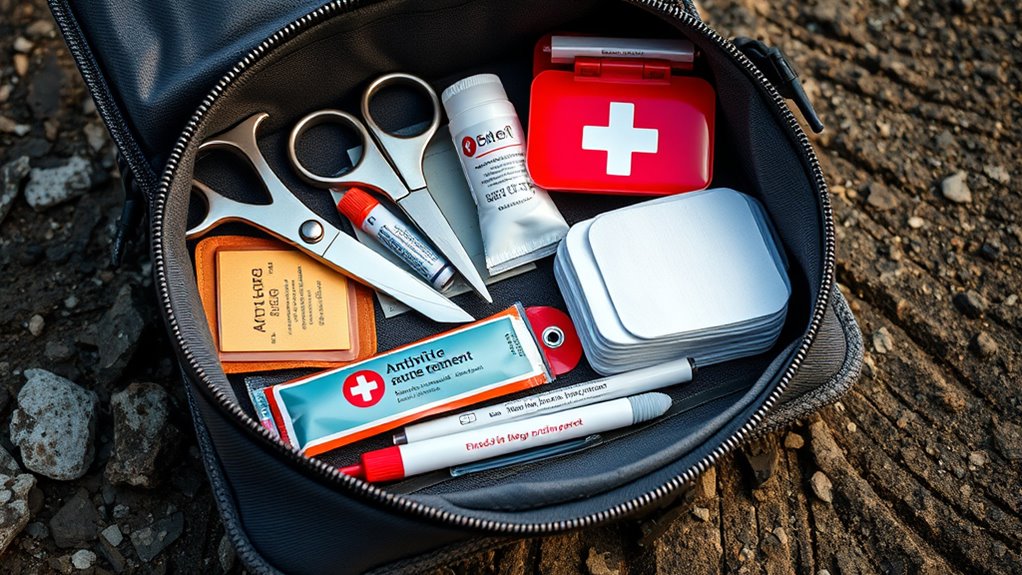
Effective wound management starts with having the right tools on hand. A well-stocked first-aid kit should include sterile gauze, non-stick dressings, medical tape, antiseptic wipes, and scissors for clean cuts. These tools help you quickly assess and control bleeding while minimizing infection risk. Your canine health assessment skills are essential to determine the wound’s severity and decide if professional help is needed. Obtaining a dog first aid certification can improve your ability to handle wounds effectively, ensuring you’re prepared for any situation. Having these essentials ready allows you to perform initial wound care confidently, stabilizing your working dog until further treatment. Remember, proper tools make all the difference in promoting faster healing and preventing complications.
Medications and Topicals
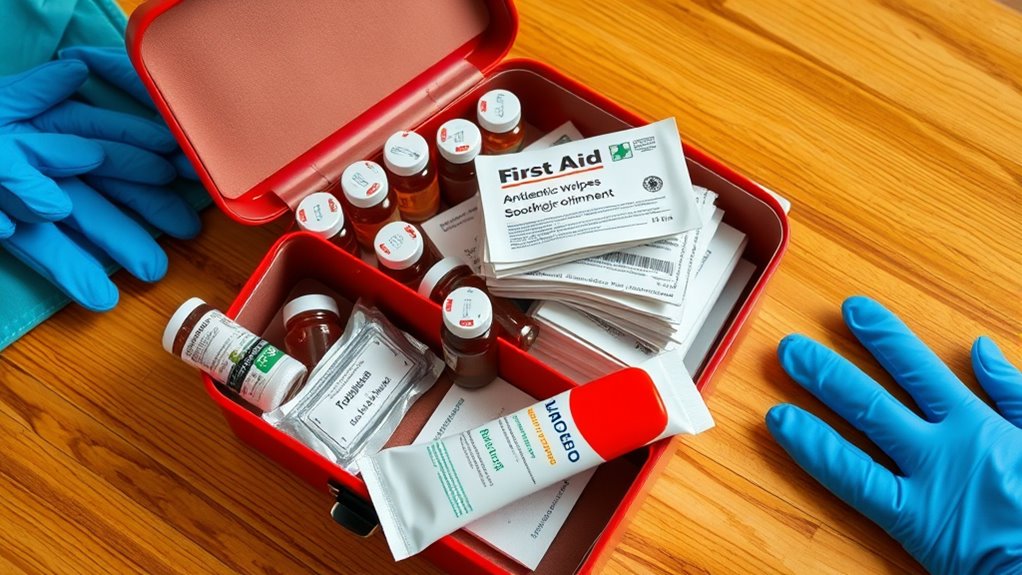
Having the right medications and topicals on hand can make a significant difference in treating minor injuries and preventing infections in working dogs. Proper medication storage guarantees these items stay effective and safe. For topical application, choose antiseptic creams, antibiotics, and wound ointments to speed healing. Keep medications organized in a waterproof container and check expiry dates regularly. Use the table below to help you select essential items:
| Medication/Topical | Purpose | Storage Tips |
|---|---|---|
| Antibiotic ointment | Prevent infection | Store in a cool, dry place |
| Antiseptic solution | Clean wounds | Keep tightly sealed |
| Pain relief cream | Reduce discomfort | Keep out of reach of children |
These essentials ensure you’re prepared to treat minor issues quickly and effectively.
Restraint and Immobilization Devices
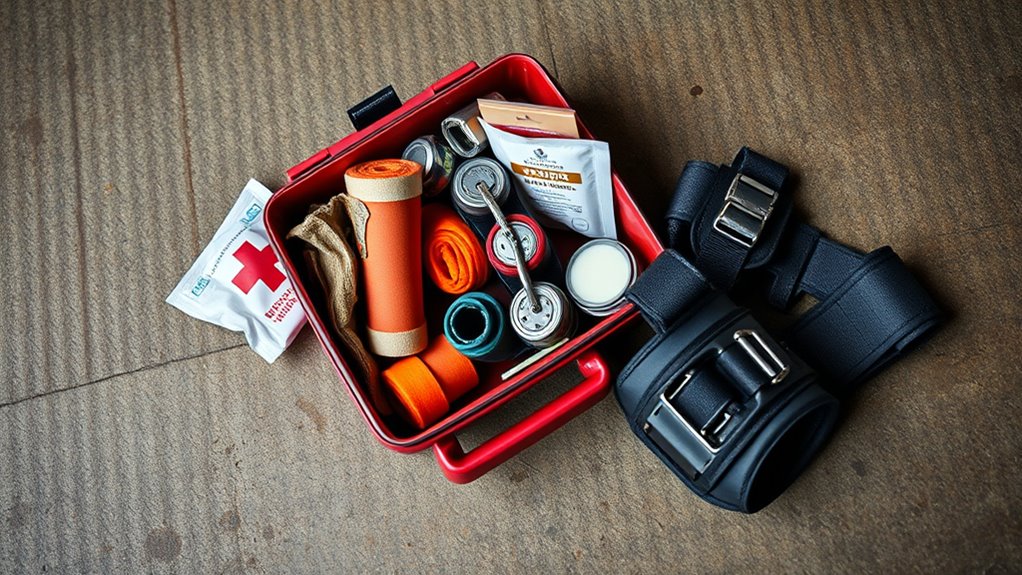
Restraint and immobilization devices are essential tools for managing a working dog’s safety during emergencies. Knowing the different types and how to apply them correctly can prevent further injury. Always follow safety precautions to protect both the dog and yourself.
Types of Restraint Devices
Choosing the right restraint device is essential for safely controlling a working dog during emergencies or training. Harness types vary to suit different tasks, from front-clip harnesses for better control to harnesses designed for specific activities. Muzzle varieties also serve important safety functions, preventing biting while allowing breathing and panting. Leather muzzles offer durability, while basket muzzles provide comfort and visibility. Slip muzzles are quick to apply but less secure. When selecting restraints, consider your dog’s size, temperament, and the situation’s demands. Proper restraint devices help manage your dog effectively without causing harm or stress. Always choose equipment that fits well and is appropriate for the task, ensuring safety for both your dog and those around you.
Proper Application Techniques
Proper application of restraint and immobilization devices is crucial to guarantee your working dog’s safety and effectiveness. When using these devices, always ensure they fit correctly to prevent discomfort or injury. Secure the device firmly, but not so tight that it restricts circulation, especially if you need to perform dog CPR or manage pet bleeding. Proper restraint allows you to control the dog’s movements without causing stress or pain. When immobilizing a dog, support the head and limbs appropriately. Check for signs of distress, such as breathing difficulty or swelling. Using these techniques correctly minimizes risks and improves your ability to assist effectively in emergencies. Always practice restraint applications beforehand so you’re prepared to act swiftly and confidently when it matters most.
Safety Precautions
Ensuring safety during the use of restraint and immobilization devices is essential to protect both the handler and the dog. When applying these devices, stay calm and gentle to prevent causing stress or injury. Proper dog training helps the dog remain calm during restraint, reducing the risk of sudden movements. Always check that devices fit correctly—too tight can cause injury, too loose may be ineffective. Avoid using force or improvised tools that could harm your dog. If your working dog is recovering or needs nutritional support, consider nutritional supplements to promote healing and reduce stress. Remember, safety precautions are critical to prevent accidents and guarantee effective treatment. Proper training and careful handling are key to maintaining a secure environment for everyone involved.
Personal Protective Equipment
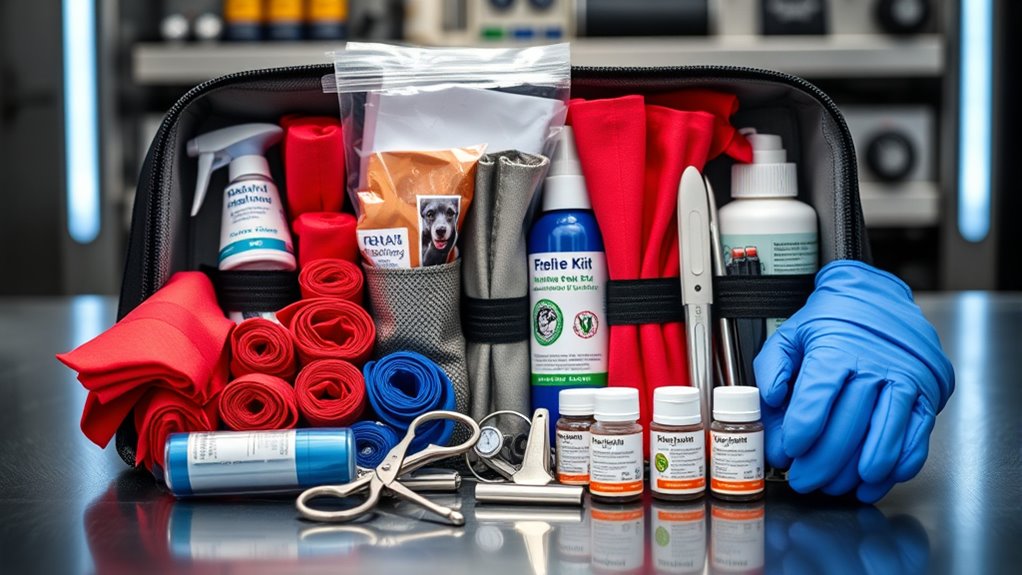
Personal protective equipment (PPE) is essential for keeping both you and working dogs safe during first aid procedures. Using the right PPE minimizes the risk of infection and protects you from bites or scratches. Always wear gloves to prevent contact with blood or bodily fluids. Eye protection, like goggles, shields your eyes from debris or fluids. A protective apron or coveralls can prevent contamination of your clothing and skin. Prioritizing dog safety means handling animals calmly and carefully, but PPE adds an extra layer of security. Remember, PPE isn’t just for your safety; it ensures the injury management doesn’t worsen. Incorporate these essentials into your first aid kit to stay prepared and maintain a safe environment for everyone involved.
Emergency Contact and Instruction List
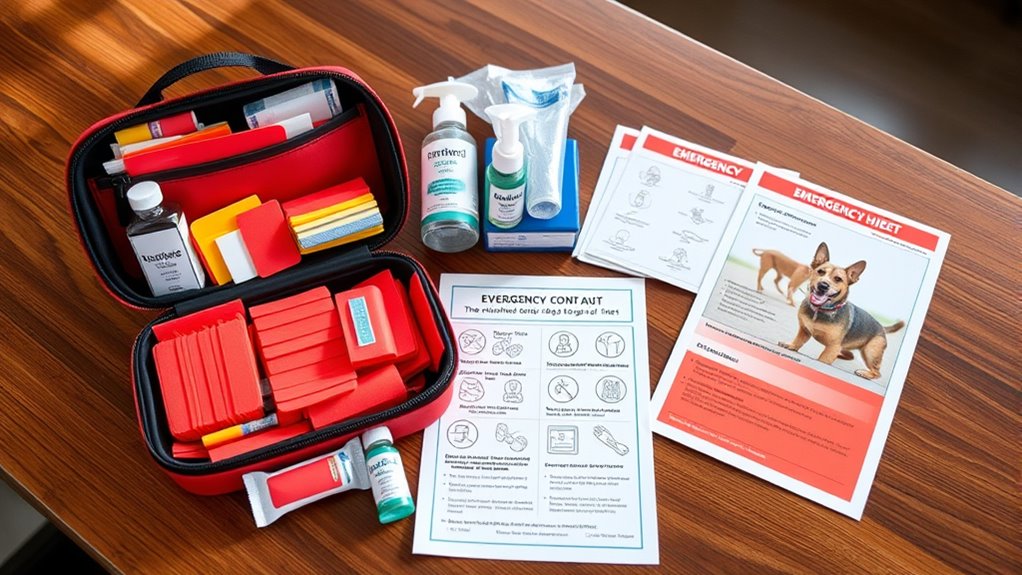
Do you have a clear, accessible list of emergency contacts and instructions ready for your working dog’s first aid kit? An emergency contact list is crucial in urgent situations. Include nearby veterinary clinics, your veterinarian, local animal poison control, and any emergency services you might need. Make sure the list is up-to-date and easy to read. Additionally, prepare an instruction list detailing your dog’s medical history, known allergies, medication details, and specific first aid steps you can follow if immediate help isn’t available. Keep this information concise but extensive. By having a well-organized emergency contact and instruction list, you guarantee quick access in stressful moments, helping you act swiftly and effectively to care for your working dog.
Additional Items for Specific Situations
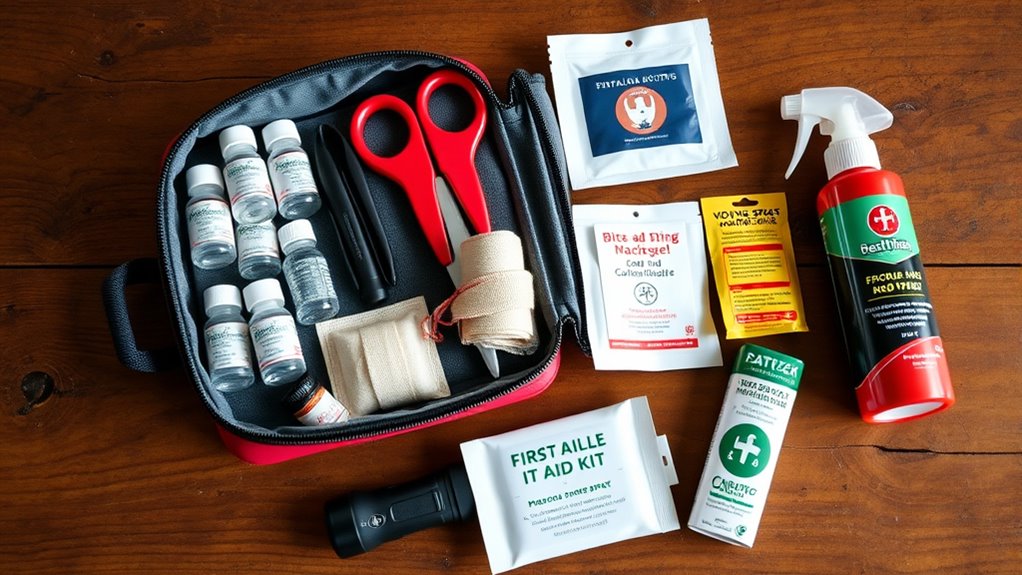
Different situations may require you to have additional items in your first-aid kit to effectively address specific injuries or emergencies. Depending on your working dog’s environment, you might need specialized equipment or advanced medical supplies. These tools help you manage complex injuries until professional help arrives. For instance, if your dog sustains a deep puncture, you’ll want to include items like a tourniquet or hemostatic dressings. Similarly, if you’re operating in remote areas, a portable splint or a thermal blanket can be lifesavers. Having these specialized items guarantees you’re prepared for diverse scenarios. Keep your kit updated with these advanced supplies to respond quickly and effectively, minimizing injury severity and promoting faster recovery.
Frequently Asked Questions
How Often Should I Check My Working Dog’s First-Aid Kit?
You should check your working dog’s first-aid kit at least once a month to guarantee proper kit maintenance and supply rotation. Regular inspections let you replace expired items, replenish used supplies, and confirm everything is in working order. This routine helps you stay prepared for emergencies and keeps your dog’s first-aid kit reliable and effective, giving you peace of mind when working in the field.
Can I Use Human First-Aid Supplies on Dogs?
Did you know that around 68% of pet owners have used human medication on their dogs? You should avoid using human first-aid supplies on dogs because many human medications and supplies aren’t safe for them. Instead, opt for pet-specific supplies, which are formulated to be safe and effective for canine injuries. Always consult your veterinarian before administering any treatment, ensuring your working dog gets the proper care.
What Should I Do if a Dog Ingests a Harmful Substance?
If your dog ingests a harmful substance, act quickly and stay calm. Call your veterinarian or emergency animal poison control immediately for guidance. Do not try to induce vomiting unless instructed. Monitor your dog closely for signs of toxin ingestion, such as vomiting, seizures, or difficulty breathing. Your prompt emergency response can make all the difference, so follow professional advice and get your dog to a vet as soon as possible.
How Do I Recognize Signs of Shock in a Working Dog?
Imagine your dog’s life hanging by a thread—that’s when recognizing signs of shock becomes crucial. Look for rapid breathing, pale gums, weakness, or a rapid pulse—these dog health indicators signal trouble. Your emergency response techniques should include keeping the dog warm, calming it, and seeking immediate veterinary help. Spotting these signs early can be the difference between life and death, so stay vigilant in your care.
Are There Specific First-Aid Items for Different Dog Breeds or Sizes?
You might wonder if there are breed-specific supplies or size-adjusted kits for your working dog. While general first-aid items work for most breeds, larger dogs benefit from bigger bandages and padding, whereas smaller breeds need more precise, compact supplies. Breed-specific supplies are useful for certain medical needs, but most first-aid kits should be customized by size to ensure quick, effective treatment during emergencies.
Conclusion
Having these first-aid kit essentials ready is like having a safety net beneath a tightrope walker—you’ll feel more confident and prepared to handle emergencies. Whether it’s a minor scrape or a more serious injury, quick access to the right supplies can make all the difference. Keep your kit organized and stocked regularly, so when an incident occurs, you’re ready to act swiftly. Remember, being prepared is the best way to protect your working dog when it matters most.

